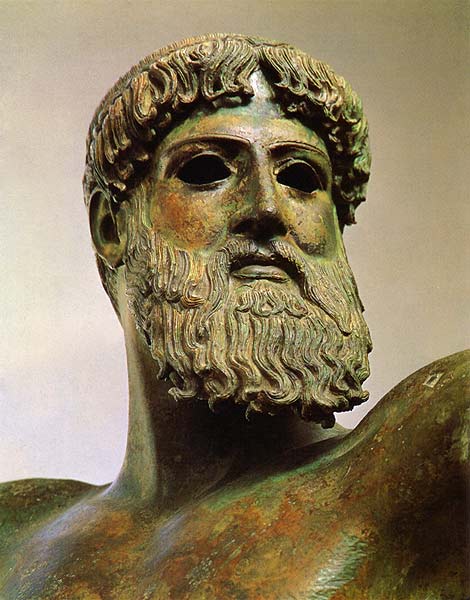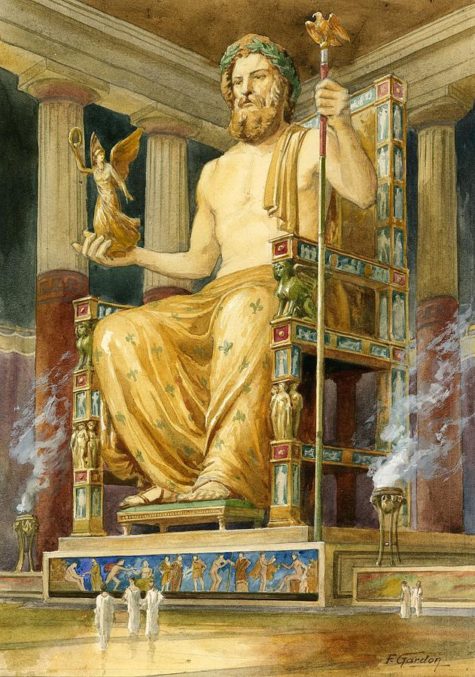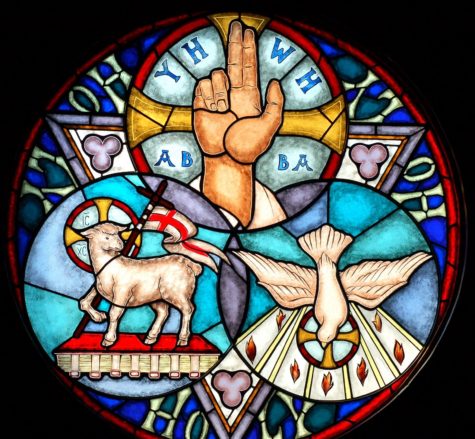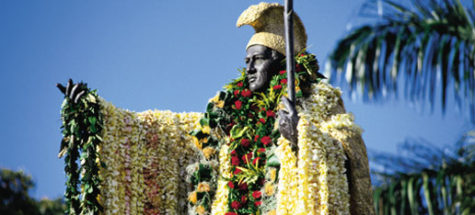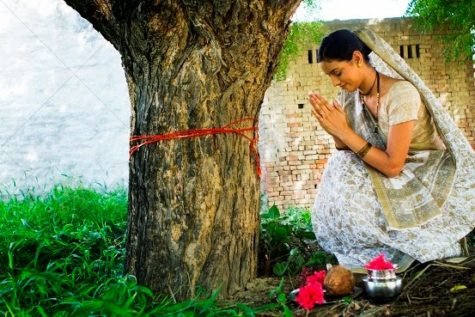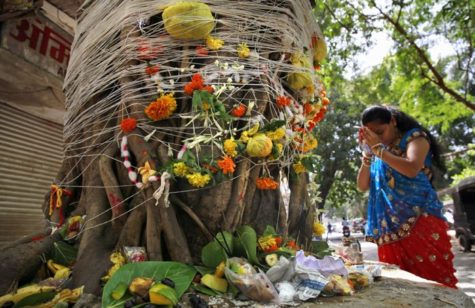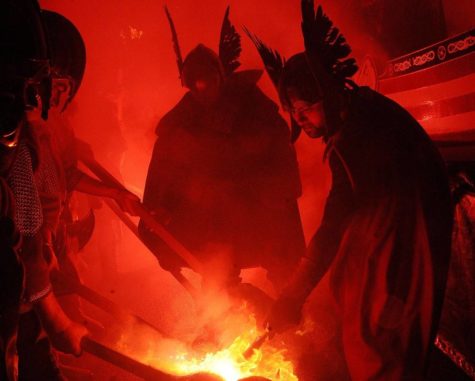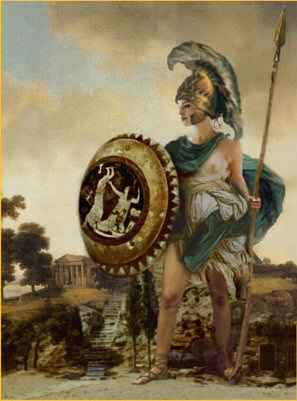Light gold-colored candles on your altar and wear oak leaves in your hair to honor the Greek god Zeus, who is traditionally honored on June 12.
The Olympic Games were originally held in honor of Zeus, the king of the Greek gods, and a sacrifice of 100 oxen was made to the god on the middle day of the festival. According to legend, the altar of Zeus stood on a spot struck by a thunderbolt, which had been hurled by the god from his throne high atop Mount Olympus, where the gods assembled.
These Games were held every four years. This four-year period acquired the name “Olympiad”, and was used as a date system: time was counted in Olympiads, rather than years.
Athletes prayed to the gods for victory, and made gifts of animals, produce, or small cakes, in thanks for their successes.
Over time, the Games flourished, and Olympia became a central site for the worship of Zeus. Individuals and communities donated buildings, statues, altars and other dedications to the god. The most spectacular sight at Olympia was the gold and ivory cult statue of Zeus enthroned, which was made by the sculptor Pheidias and placed inside the temple.
The statue was one of the Seven Wonders of the Ancient World, and stood over 42 feet high. A spiral staircase took visitors to an upper floor of the temple, for a better view of the statue.
People who were not Greek could not compete in the Games, but Greek athletes traveled hundreds of miles, from colonies of the Greek city-states. These colonies were as far away as modern-day Spain, Italy, Libya, Egypt, Ukraine, and Turkey.
After the 2nd century A.D., the Roman empire brought even more competitors to the Olympic Games, but regional differences always gave the Olympics an international flavor.
Trinity Sunday is celebrated in all the Western liturgical churches: Roman Catholic, Anglican, Lutheran, Presbyterian, United Church of Christ, and Methodist.
Trinity Sunday is the first Sunday after Pentecost and is celebrated by many Christians in the United States. It is one of the few feasts that are celebrated as a doctrine of the church rather than an event in its sacred history. It is also symbolic of the unity of the Trinity.
On Trinity Sunday many Christians around the world remember and honor the belief of an eternal God, consisting of the Father, Son and Holy Spirit. Many churches have special prayers on Trinity Sunday. The Athanasian Creed, named after St Athanasius, Archbishop of Alexandria, is recited in some churches on Trinity Sunday because of its strong affirmation of the Triune nature of God.
In pre-revolutionary Russia, Trinity Sunday was a grand celebration. Churches and homes were decorated with wreaths, fresh flowers and grass and saplings. It was a time of weddings, and young unwed women would sometimes toss fresh wreaths during the next year. If a wreath floated the woman was destine to marry. If it sank, she would remain unwed. With the coming of communism came the belief that holidays were a way of exploiting the masses and preventing productivity. This particular holiday was turned into an arbor day.
In traditional Methodist usage, The Book of Worship for Church and Home (1965) provides the following Collects for Trinity Sunday:
Almighty and everlasting God, who hast given unto us thy servants grace, by the confession of a true faith, to acknowledge the glory of the eternal Trinity, and in the power of the divine majesty to worship the unity: We beseech thee to keep us steadfast in this faith and evermore defend us from all adversities who livest and reignest, one God, world without end. Amen.
Almighty and everlasting God, who hast revealed thyself as Father, Son, and Holy Spirit, ,and dost ever live and reign in the perfect unity of love: Grant that we may always hold firmly and joyfully to this faith, and, living in praise of thy divine majesty, may finally be one in thee; who art three persons in one God, world without end. Amen.
Johann Sebastian Bach composed a number of cantatas for Trinity Sunday. Including:
- O holy bath of Spirit and water – O heilges Geist- und Wasserbad, BWV 165
- There is something defiant and fainthearted – Es ist ein trotzig und verzagt Ding, BWV 176
- Most highly desired festival of joy – Gelobet sei der Herr, mein Gott, BWV 129.
Collected from various sources
- Color of the day: Green
- Incense of the day: Clove
June 11 is the Festival of Mater Matuta, an old Italian goddess of the dawn who was the goddess of the dawn and the protector of growing crops and growing children. Today a free woman in the first year of her marriage would make offerings of toasted cakes to the goddess, and ask for blessings on her nieces and nephews. The Romans eventually made equivalent to the dawn goddess Aurora, and the Greek goddess Eos.
Aurora, known among the Greeks as Eos, is honored on this day. It is she who opens the gates of heaven each day so that Helios may ride his chariot across the skies. Her tears create the morning dew. Try greeting Aurora today as she opens the gates of heaven. Walk barefoot through the grass, feeling her tears upon your skin. Connect with her eternally youthful soul.
Then, as Helios begins his journey across the sky, settle yourself in a quiet place outdoors and let the light bathe your face for a short time as you meditate on the beauty you bring into your world each day. Once you finish your meditations, pay tribute to Aurora for her task of opening the gates for each new day to bring light in the world. Take with you her beauty and grace as you go about your day and tasks.
By Winter Wren
Hawaii is the only American state that was once a kingdom with its own monarchy. One of the greatest kings was King Kamehameha I, also called, appropriately, Kamehameha the Great. His name means “the very lonely one” or “the one set apart.” A statue of him can be found in the National Statuary Hall in the U.S. Capitol building in Washington, D.C.
King Kamehameha I probably was born some time around 1758, the year when Halley’s comet became visible over Hawaii. A courageous warrior, the king conquered and united the entire Hawaiian islands into one kingdom. During his reign, which lasted from 1782 to 1819, Hawaii became an important center in the fur and sandalwood trades.
The last king in the Kamehameha dynasty was King Kamehameha V, who ruled from 1863 to 1872. During this time, the king proclaimed June 11 as a day to honor his grandfather, King Kamehameha I.
The most important ritual of the celebration dates back to 1901 after the Territory of Hawaii was established. It is the afternoon draping ceremony in which the Kamehameha Statue in front of Aliʻiolani Hale and ʻIolani Palace on King Street in downtown Honolulu is draped in long strands of lei. The same is done at the Kamehameha Statue on the former monarch’s home island, the Big Island of Hawaii. Outside of the state, a similar draping ceremony is held at the United States Capitol where the Kamehameha Statue there is also draped in lei in the company of federal officials.
Late 19th century celebrations of Kamehameha Day featured carnivals and fairs, foot races, horse races and velocipede races. Today, Kamehameha Day is treated with elaborate events harkening back to ancient Hawaii, respecting the cultural traditions that Kamehameha defended as his society was slowly shifting towards European trends.
The King Kamehameha Hula Competition attracts hula groups from all over the world to the Neil S. Blaisdell Center for the two-day event. Prizes are awarded on the second night.
A floral parade is held annually at various locations throughout the state of Hawaii. On the island of Oahu, the parade runs from ʻIolani Palace in downtown Honolulu past Honolulu Harbor and the Prince Kūhiō Federal Building through Kakaʻako, Ala Moana and Waikīkī, ending at Kapiʻolani Park.
June 11 is also the anniversary of the dedication of Kapiʻolani Park. The floral parade features local marching bands—including the Royal Hawaiian Band (the oldest municipal band in the United States)—and artistically designed floats using native flowers and plants. Many local companies enter floats for their employees.
A favorite floral parade feature is the traditional royal paʻu riders. They represent a royal court led by a queen on horseback, followed by princesses representing the eight major islands of Hawaii and Molokini. Each princess is attended by paʻu ladies in waiting. Paʻu women are dressed in colorful and elegant 19th century riding gowns accented with lei and other floral arrangements.
After the parade, the state celebrates a Hoʻolauleʻa, literally celebration, or block party with food and music. Cultural exhibitions are also scattered throughout Kapiʻolani Park—arts and crafts, games, sports, and other events planned by the Bishop Museum, the premier Hawaiian cultural institution.
On the Island of Hawaii, there are three floral parades held. One between the towns of Hawi and Kapaʻau and one in the town of Hilo. There is a King Kamehameha Day Celebration Parade and Ho`olaule`a in Kailua Kona on Ali`i Drive each year. There is also a lei draping ceremony in Kapaau at the statue of King Kamehameha there.
Sources: Almanac.com and Wikipedia
The dates for this ritual varies from year to year. The word ‘Purnima’ means full moon, therefore the Vat purnima vrat is observed on the full moon day (15th day) of the Hindu month of Jyeshtha that is during the month of May-June as per the Gregorian calendar. In 2017, this falls on June 9. In 2018 it will fall on June 27.
Vat Purnima or Wat Purnima (वट पूर्णिमा, vaṭapūrṇimā, also called Vat Savitri is a celebration observed by married women in the Western Indian states of Gujarat, Maharashtra, Karnataka and some regions of eastern Uttar Pradesh. On this Purnima, a married woman marks her love for her husband by tying a ceremonial thread around a banyan tree. The celebration is based on the legend of Savitri and Satyavan as narrated in the epic Mahabharata.
The Legend:
The legends dates back to a story in the age of Mahabharata. The childless king Asvapati and his consort Malavi wish to have a son. To have a child, he performed penances and offered prayers. Finally the God Savitr appears and tells him he will soon have a daughter. The king is overjoyed at the prospect of a child. She is born and named Savitri in honor of the god.
Since she was born due to her father’s severe penances, she naturally led an ascetic life. However, she is so beautiful and pure,all the men in her village are intimidated and no man will ask for her hand in marriage. Her father tells her to find a husband on her own. She sets out on a pilgrimage for this purpose and finds Satyavan, the son of a blind king named Dyumatsena who lives in exile as a forest-dweller. Savitri returns to find her father speaking with Sage Narada who tells her she has made a bad choice: although perfect in every way, Satyavan is destined to die one year from that day.
Her father asked her to find someone else, but she refused, saying that she could select a man only once in a lifetime since she was of an ascetic spirit. Narada and her father agree. Savitri insists on going ahead and marries Satyavan.
 Three days before the foreseen death of Satyavan, Savitri takes a vow of fasting and vigil. Her father-in-law tells her she has taken on too harsh a regimen, but she replies that she has taken an oath to perform the regimen and Dyumatsena offers his support. The morning of Satyavan’s predicted death, he is splitting wood and suddenly becomes weak and lays his head in Savitri’s lap and dies.
Three days before the foreseen death of Satyavan, Savitri takes a vow of fasting and vigil. Her father-in-law tells her she has taken on too harsh a regimen, but she replies that she has taken an oath to perform the regimen and Dyumatsena offers his support. The morning of Satyavan’s predicted death, he is splitting wood and suddenly becomes weak and lays his head in Savitri’s lap and dies.
Savitri places his body under the shade of a Vat (Banyan) tree. Soon, the messengers of Yama appear on the scene to take away her husband, but Savitir refuses to hand her husband over to them. They can not take him away until Lord Yama Himself appears. Savitri follows him as he carries the soul away. She offers him praise. Lord Yama, impressed by both the content and style of her words, and seeing her matchless devotion, spiritual knowledge, and determination, offers her a boon.
She first asks for eyesight and restoration of the kingdom for her father-in-law, then a hundred children for her father, and then a hundred children for herself and Satyavan. The last wish creates a dilemma for Yama, as it would indirectly grant the life of Satyavan. However, impressed by Savitri’s dedication and purity, he asks her to wish one more time, “forgetting” to mention his denial to grant the third wish.
Savitri immediately asked for the life of Satyavan. The death god Yama who does not spare even an ant, grants life to Satyavan and blesses Savitri’s life with eternal happiness.
Satyavan awakens as though he has been in a deep sleep and returns to his parents along with his wife. Meanwhile, at their home, Dyumatsena regains his eyesight before Savitri and Satyavan return. Since Satyavan still does not know what happened, Savitri relays the story to her parents-in-law, husband, and the gathered ascetics. As they praise her, Dyumatsena’s ministers arrive with news of the death of his usurper. Joyfully, the king and his entourage return to his kingdom.
Though the tree does not play a significant role of the story, The banyan tree holds a unique significance in Hindu religion. As per the Hindu scriptures, it holds the essence of the three great Gods in Hindu mythology, Brahma-Vishnu-Mahesh. The roots represents Brahma, the stem of Vat Vriksha is Vishnu while Shiva represents the upper part. It is believed that performing the rituals of the puja under this sacred tree, the devotees can fulfill all their desires. It is also worshiped in memory of the love in the legend.
Observing the Vat Purnima:
The festival is followed by married women only, and is prohibited for children and widows. On this day wives pray to the Divine for their husbands’ prosperity and longevity by performing Vat Purnima Puja Vidh which includes tying ritual threads around the trunk of a banyan tree; this ritual is also called the Peepal Puja.
In the present day, the festival is celebrated in the following way. Women dress in fine saris and jewelry, and their day begins with the offering of any five fruits and a coconut. Each woman winds white thread around a banyan tree seven times as a reminder of their husbands. They fast for the whole day.
The fast is also sometimes observed throughout the night until the next morning. The next morning women break their fast and offer charity to Brahmins. Women engage in the worship of a banyan tree, and listen to the legend of Savitri.
After, the women offer water to the tree and spread red powder (kumkum) on it, cotton threads are wrapped around the tree’s trunks and they do parikrama or circumambulate seven times around it.
Alternatively, on the occasion of Vat Purnima, women keep a fast of three days for their husbands, as Savitri did. During the three days, pictures of a Vat (banyan) tree, Savitri, Satyavan, and Yama, are drawn with a paste of sandal and rice on the floor or a wall in the home. The golden engravings of the couple are placed in a tray of sand, and worshiped with mantras (chanting), vermilion, saffron, sandalwood incense, fruit, and Vat leaves.
Outdoors, the banyan tree is worshiped. A thread is wound around the trunk of the tree, and copper coins are offered. Strict adherence to the fast and tradition is believed to ensure the husband a long and prosperous life. During the fast, women greet each other with “जन्म सावित्री हो” (English: “Become a Savitri”). It is believed that until the next seven births their husband will live well.
Just in the way that Savitri got her husband, Satyavan back from Yumraj, it is known that women who observe this auspicious fast will be blessed with good fortune and blissful married life.
Information collected from various sources.
What follows is a list (in alphabetical order) of the names given to the June moon. Also listed is the tradition and/or origin of that moon name:
- Aerra Litha Moon ~other
- Blackberry Moon ~Greek
- Buffalo Moon ~Omaha
- Corn Tassel Moon ~Taos
- Dark Green Leaves Moon ~Pueblo
- Dyad Moon ~Medieval English
- Fish Spoils Moon ~Wishram
- Flower Moon ~Cherokee
- Green Corn Moon ~Cherokee
- Green Grass Moon ~Sioux
- Hay Moon ~other
- Hoer Moon ~Abernaki
- Horses’ Moon ~Celtic
- Honey Moon ~Algonquin
- Hot Moon ~Algonquin
- Hot Weather Moon ~Ponca, Arapaho
- Leaf Moon ~Assiniboine
- Leaf Dark Moon ~San Juan
- Leaves Moon ~Cree
- Lotus Moon ~Chinese
- Lovers’ Moon ~other
- Major Planting Moon ~Hopi
- Making Fat Moon ~Lakota
- Mead Moon ~Janic (full)
- Planting Moon ~Neo Pagan
- Ripe Berries ~Dakota
- Ripening Moon ~Mohawk
- Rose Moon ~Algonquin
- Strawberry Moon ~Anishnaabe, Dark Janic, Algonquin
- Strong Sun Moon ~other
- Summer Moon ~Kiowa, Passamaquoddy
- Turtle Moon ~Potawatomi
- Water Melon Moon ~Natchez
- Windy Moon ~Choctaw
At the outbreak of the Peloponnesian War, the Athenians allowed the founding of a sanctuary for the Goddess Bendis and shortly afterward created a state festival, the Bendideia, for her.The first celebration was held on the 19th of Thargelion (May–June), 429 BC, at the Piraeus, the seaport of Athens.
Many pagan calendars list June 6th as the modern equivalent date for this festival honoring the Moon Goddess of Thrace. Other sources give that her festivals were held on the full moon preceding or coinciding with the solstice – and if so, the dates would vary from year to year.
For a description of the festival we have this excerpt of a conversation between Socrates and a friend describing that festival (from Plato’s Republic):
Sokrates: “I went down yesterday to the Peiraios (Piraeus) with Glaukon (Glaucon), the son of Ariston, to pay my devotions to the Goddess [Bendis], and also because I wished to see how they would conduct the festival since this was its inauguration. I thought the procession of the citizens very fine, but it was no better than the show, made by the marching of the Thrakian contingent [i.e. the mercenary force who policed ancient Athens]. After we had said our prayers and seen the spectacle we were starting for town . . . “
‘Do you mean to say,’ interposed Adeimantus, ‘that you haven’t heard that there is to be a torchlight race this evening on horseback in honor of the Goddess?’
‘On horseback?’ said I. ‘That is a new idea. Will they carry torches and pass them along to one another as they race with the horses, or how do you mean?’
‘That’s the way of it,’ said Polemarkhos, ‘and, besides, there is to be a night festival which will be worth seeing. For after dinner we will get up and go out and see the sights and meet a lot of the lads there and have good talk . . . Let this complete your entertainment, Sokrates, at the festival of Bendis.’
In 1972, the United Nations General Assembly established this observance to raise environmental awareness worldwide. (The event’s June 5 date was chosen to coincide that first year with the start of the 1972 United Nations Conference on the Human Environment, in Stockholm, Sweden.) Each year, a related international event takes place, as well as events in many countries, such as bicycle parades and tree planting.
From: Almanac.com
The Festival of Bellona took place on June 3rd in Campus Martius, near the Temple of Bellona. This was largely just a huge feast in honor of Bellona who had helped them in war. This festival was also a celebration for the dedication of the Temple of Bellona.
One source that talks about the dedication of the Temple of Bellona on June 3rd is in Ovid’s “Fasti”, a six book poem the Roman poet Ovid had published around 8 AD. This quote is found in Ovid’s 6th and final book:
“When two dawns are past, and Phoebus has risen twice,
And the crops have twice been wet by the dewfall,
On that day, they say, during the Tuscan War, Bellona’s
Shrine was consecrated, she who always brings Rome success.”
This goddess did not play a significant role in either myth or legend, and her worship appears to have been promoted in Rome chiefly by the family of the Claudii, whose Sabine origin, together with their use of the name of Nero, has suggested an identification of Bellona with the Sabine war goddess Nerio.
Her temple at Rome, dedicated by Appius Claudius Caecus (296 B.C.) in fulfillment of a a vow during the Third Samnite War with the Samnites and Etruscans, stood in the Campus Martius, near the Flaminian Circus and Porta Carmentalis (the Carmenta gate), and outside the gates of the city. It was there that the senate met to discuss a general’s claim to a triumph, and to receive ambassadors from foreign states. In front of it was the columna bellica, where the fetialis ceremony of declaring war was performed, in which a spear was cast against the distant enemy.
Note:
This native Italian goddess should not be mistaken for the Asiatic Bellona, whose worship was introduced into Rome apparently by Sulla, to whom she had appeared, urging him to march to Rome and bathe in the blood of his enemies. See Day of Blood
~Information compiled from various sources.
Good weather in “Flaming June” is necessary if there is to be a good harvest. Country weather lore states:
- If June with bright sun is blessed, for harvest, we will thank the Goddess.
- If June be sunny, harvest comes early.
- A cold and wet June ruins the rest of the year.
- It is said that if it rains on 27 June, then it will rain for the next seven weeks.
- A wet June makes a dry September.
- A dripping June brings all things in tune.
- If swallows fly near the ground in June, it is a sign of coming rain.
- Bats flying on a June evening are a sign of hot, dry weather the next day.
- A calm June puts the farmer in tune.
- June damp and warm, does the farmer no harm.
- Rain on St Vitus’ Day (June 15), brings rain for 30 days in a row.
According to country lore, it was also claimed that summer doesn’t actually begin until the elder is in flower.
Information collected from: various sources
